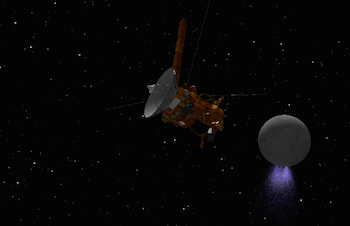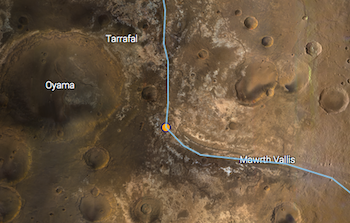Sonhar Com Mundos Distantes Possibilidades Eternas.
Sonhar Com mundos distantes Possibilidades Eternas.
Solar System: Top 5 Things to Know This Week
1. A Ceres of Fortunate Events

Our Dawn mission continues its exploration at Ceres, and the team is working with the data coming back to Earth, looking for explanations for the tiny world’s strange features. Follow Dawn’s expedition HERE.
2. Icy Moon Rendezvous

One of the most interesting places in the entire solar system is Saturn’s moon Enceladus, with its underground ocean and spectacular geyser plume. This month, the Cassini spacecraft will be buzzing close by Enceladus several times, the last such encounters of the mission. On October 14, Cassini will perform a targeted flyby at a distance of just 1,142 miles (1,838 kilometers) over the moon’s northern latitudes. Ride along with Cassini HERE.
3. Make Your Own Mars Walkabout

You can retrace Opportunity’s journey, see where the Curiosity rover is now, or even follow along with fictional astronaut Mark Watney from The Martian movie using the free online app MarsTrek. The app lets you zoom in on almost any part of the planet and see images obtained by our spacecraft, so you can plan your on Red Planet excursion. Take a hike HERE.
4. Elusive Features on Jupiter

New imagery from our Hubble Space Telescope is capturing details never before seen on Jupiter. High-resolution maps and spinning globes, rendered in the 4K Ultra HD format, reveal an elusive wave and changes to Jupiter’s Great Red Spot. Explore Jupiter HERE.
5. Mr. Blue Sky

Another week, another amazing picture from Pluto. The first color images of Pluto’s atmospheric hazes, returned by our New Horizons spacecraft last week, reveal that the hazes are blue. Who would have expected a blue sky in the Kuiper Belt? Most of the data collected during July’s Pluto flyby remains aboard the spacecraft, but the team publishes new batches of pictures and other findings on a weekly basis. Keep up with the latest HERE.
Make sure to follow us on Tumblr for your regular dose of space: http://nasa.tumblr.com
More Posts from Ritasakano and Others
Interessante!!!

Everyone pitches in for protein synthesis! Here are three types of RNA helping your cells make proteins. Be sure to check out all our science GIFs here for your studyblrs, teacher websites, presentations, or general amusement! Just please keep our name on there and don’t sell them! :D
Modesto Carvalhosa on Twitter

Katsushika Hokusai (葛飾北斎?, outubro ou novembro de 1760 – 18 de abril de 1849) foi um artista japonês, pintor de estilo ukiyo-e e gravurista do período Edo. Em sua época, era um dos principais especialistas em pintura chinesa do Japão.[1] Nascido em Edo (atual Tóquio), Hokusai é melhor conhecido como autor da série de xilogravuras Trinta e seis vistas do monte Fuji (富嶽三十六景, Fugaku Sanjūroku-kei?, c. 1831) que inclui sua pintura icônica e internacionalmente conhecida, A Grande Onda de Kanagawa, criada durante a década de 1820.










Katsushika Hokusai

Qual cor Cor rosa Rosa cor Tem

Árvore Pirâmide em feltro bordada. By Rita Sakano
Sakura uma paixão eterna!!








Cherry Blossoms
-
 deathicus-sling reblogged this · 2 years ago
deathicus-sling reblogged this · 2 years ago -
 softeningandripening liked this · 6 years ago
softeningandripening liked this · 6 years ago -
 fredrick-smith liked this · 7 years ago
fredrick-smith liked this · 7 years ago -
 impala-moose liked this · 7 years ago
impala-moose liked this · 7 years ago -
 madokakaname1 reblogged this · 7 years ago
madokakaname1 reblogged this · 7 years ago -
 ageorgebir liked this · 8 years ago
ageorgebir liked this · 8 years ago -
 juliejuno reblogged this · 8 years ago
juliejuno reblogged this · 8 years ago -
 weeabooslut liked this · 8 years ago
weeabooslut liked this · 8 years ago -
 amigo155 liked this · 8 years ago
amigo155 liked this · 8 years ago -
 jaihind2110 liked this · 8 years ago
jaihind2110 liked this · 8 years ago -
 juliejuno reblogged this · 9 years ago
juliejuno reblogged this · 9 years ago -
 shippingtech-blog reblogged this · 9 years ago
shippingtech-blog reblogged this · 9 years ago -
 four-leaf-charm reblogged this · 9 years ago
four-leaf-charm reblogged this · 9 years ago -
 yeezynation8-blog liked this · 9 years ago
yeezynation8-blog liked this · 9 years ago -
 aegisoracle liked this · 9 years ago
aegisoracle liked this · 9 years ago -
 happy420borderline liked this · 9 years ago
happy420borderline liked this · 9 years ago -
 seemply-d-best reblogged this · 9 years ago
seemply-d-best reblogged this · 9 years ago -
 annesully liked this · 9 years ago
annesully liked this · 9 years ago -
 megaradcollectionwolfthings-blog liked this · 9 years ago
megaradcollectionwolfthings-blog liked this · 9 years ago -
 manicuredforwar reblogged this · 9 years ago
manicuredforwar reblogged this · 9 years ago -
 manicuredforwar liked this · 9 years ago
manicuredforwar liked this · 9 years ago -
 stormy-child reblogged this · 9 years ago
stormy-child reblogged this · 9 years ago -
 tommie-james liked this · 9 years ago
tommie-james liked this · 9 years ago -
 theedsagroup-blog liked this · 9 years ago
theedsagroup-blog liked this · 9 years ago -
 mobdividual liked this · 9 years ago
mobdividual liked this · 9 years ago -
 proffesionaldreamer reblogged this · 9 years ago
proffesionaldreamer reblogged this · 9 years ago -
 alpacachigga reblogged this · 9 years ago
alpacachigga reblogged this · 9 years ago -
 khaled-taleb-blog liked this · 9 years ago
khaled-taleb-blog liked this · 9 years ago -
 anadeansky liked this · 9 years ago
anadeansky liked this · 9 years ago -
 faradayscandle liked this · 9 years ago
faradayscandle liked this · 9 years ago -
 iymerc01 liked this · 9 years ago
iymerc01 liked this · 9 years ago -
 grelse reblogged this · 9 years ago
grelse reblogged this · 9 years ago -
 fiamontague reblogged this · 9 years ago
fiamontague reblogged this · 9 years ago -
 thatgirlrobyn97 liked this · 9 years ago
thatgirlrobyn97 liked this · 9 years ago -
 melonssoup reblogged this · 9 years ago
melonssoup reblogged this · 9 years ago -
 fuyunoakegata reblogged this · 9 years ago
fuyunoakegata reblogged this · 9 years ago -
 prwtiapototelos liked this · 9 years ago
prwtiapototelos liked this · 9 years ago
